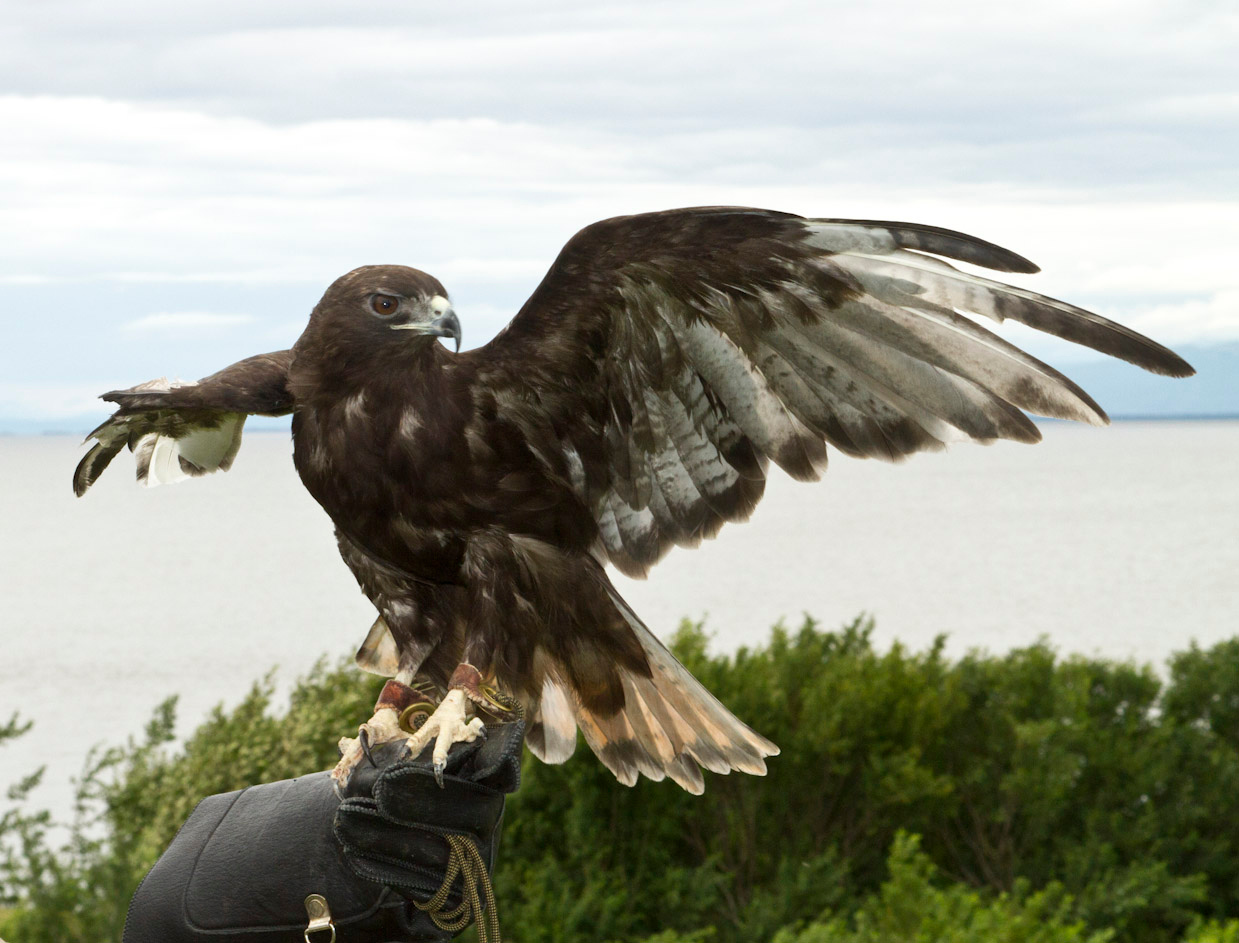Red-tailed Hawk and Sharp-shinned Hawk
The zoo is home to two hawk species, the red-tailed hawk and the sharp-shinned hawk. Back to animal directory.
red-tailed hawk
Buteo jamaicensis
LIFE SPAN: 20 years under human managed care.
RANGE: Widespread distribution across North and Central America, along with Mexico. They are also found in the Caribbean. The red-tailed hawks that live farther north are darker and breed in Alaska and Canada in the summer, then fly south to winter in the northern to mid-western United States.
SIZE: They are larger and heavier than goshawks, with an average wingspan of 4 feet and weighing close to 4 pounds.
PHYSICAL FEATURES: Red-tailed hawks are members of Buteo family, or soaring hawks. Unlike accipiters (forest hunters, like goshawks), buteos have longer wingspans and shorter tails adapted for soaring flight. They have pale chest feathers with a dark band across the belly. A reddish tail is also a key feature, however colors may vary within the species. The undersides of the wings are always light in color, with dark feathers along the leading wing edges. Both males and females look alike, however females are larger than males (typical of raptors).
FOOD: Hunt in open fields and meadows with surrounding high perches (poles, fences, trees). They prey on small to medium-sized mammals and birds. Carrion is scavenged when available. They spot prey from the air or high perches by using their excellent vision, then dive at high speeds to capture prey. They are able to hover over the ground if needed.
BEHAVIOR: This is the most common hawk in North America, often seen in lower 48 states perched on fence posts or poles. They prefer open country to perch high and look for prey. They soar high and spot prey with incredible eyesight. In some areas, they displace other hawks.Their diurnal habits allow them to hunt during daytime, while great-horned owls hunt at night.
CONSERVATION: Protected by the Migratory Bird Treaty Act. Populations are stable due to adaptability toward human presence. They are one of the most frequent patients at rehab clinics due to electrocutions, entanglements with wires, shootings, poisoning by humans and collisions with cars. Continued education regarding the value of raptors in the wild is critical for reducing the number of human-related mortalities each year.
sharp-shinned hawk
Accipiter striatus
LIFE SPAN: Average in the wild is 3 years; oldest on record was 19.9 years under human managed care.
RANGE: This hawk occupies a large range in North America, breeding North to the tree line in Alaska and Canada, and wintering as far South as Panama. They prefer to nest in old spruce trees and spend most of their time in wooded habitats.
SIZE: Wingspan is between 21 and 25 inches. Average weight is 3.5 to 6 ounces.
PHYSICAL FEATURES: Sharp-shinned hawks are in the family of supreme hunters alongside goshawks, members of the Accipiter family. Adult sharp-shinned hawks have gray backs, wings and tails. They have white underbellies that are barred with brown-orange coloration. As adults, their tails are dark gray and banded. Their eyes are red as adults, but yellow as juveniles. Females may be more brown than males. Juvenile hawks are brown on the back, wings and tail, with buff-colored underbellies that are streaked with brown coloration. As juveniles, their tails are dark brown. Like all accipiter hawks, they have short, rounded wings and long tails which allow them to maneuver with great agility during flight. This, in turn, makes them very effective hunters.
FOOD: Sharp-shinned hawks are efficient songbird hunters, so their diet consists of mainly small birds. They also will capture and eat small mammals and larger insects.
BEHAVIOR: In late April or early May these hawks lay three to six eggs in nests commonly found in middle-aged spruce trees. They young hatch in about 35 days and fledge another 25 days later. Most sharp-shinned hawks follow migrating songbirds in the fall, spending winter in warmer regions, though some may overwinter in Southcentral and Southeast Alaska.
CONSERVATION: They are protected by the Migratory Bird Treaty Act and it is illegal to harm or possess any part, including feathers (unless permitted by USFWS). The sharp-shinned hawk may be kept by falconers, providing they have the required permits issued by both the state and federal authorities. This species is listed as a species of “Least Concern” by the IUCN Red List of Threatened Species.


